Fire on Stac Pollaidh: the value of working together
,
Following last month’s wildfire at Stac Pollaidh, CALL Co-ordinator, Lizzie Williams, highlights the importance of collaborative action to tackle fires, and urges caution to minimise future risks.
Six weeks after the wildfire which blackened the slopes of Stac Pollaidh, it now glows fluorescent green with regrowth. We know that this vigorous first flush belies the full ecological cost of the fire – but we also know that the damage could have been far worse if it hadn’t been for an impressive team effort.
Stac Pollaidh is part of the Inverpolly Site of Special Scientific Interest and Special Area of Conservation – designations that show its national and international importance for various special natural features, including its oak and birch woodlands, blanket bog and subalpine wet and dry heath. It provides vital habitat for breeding birds, rare plants, moths and beetles.
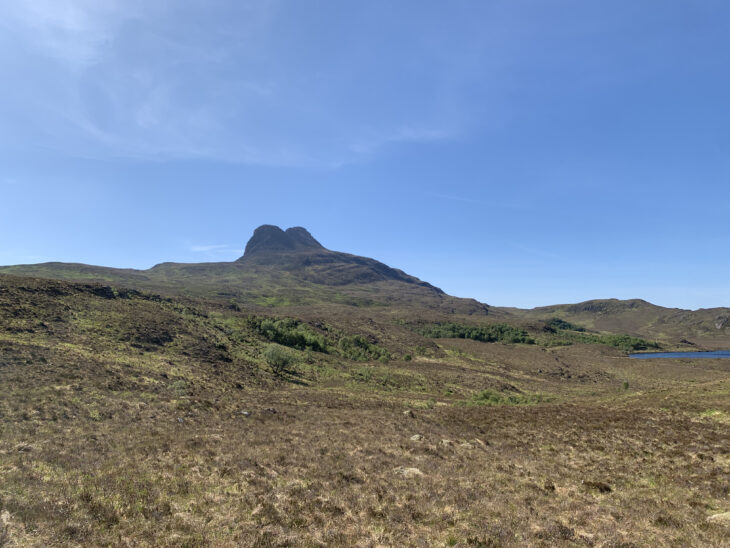
The unburned east side of Stac Pollaidh © Lizzie Wilder Williams
The Coigach & Assynt Living Landscape (CALL) partnership strives to enhance and restore nature across this stunning area. Partners have plenty of experience of the devastating effects of wildfires, including those in Assynt in May 2011, on Tanera Mòr in May 2012, Assynt again in spring 2017 and – after freak hot winds brought down a powerline – another in Assynt in January 2024. Precious woodland and other habitats established over decades; destroyed in minutes.
The global climate crisis means that the ‘freak’ conditions that are ideal for wildfires – long dry spells in winter and early spring, creating perfect tinder from the previous year’s dead vegetation – will become more commonplace.
When a fire breaks out in a remote area, it can take some time for Scottish Fire & Rescue Service (SFRS) crews to reach the site, and extensive wildfires often require large numbers of people relentlessly working with appropriate equipment to suppress them.
The CALL team – recognising the increasing risks to the area – have worked hard to consider how landowners, land managers and the wider community can collaborate to respond swiftly and effectively when fires break out. Working with CALL partners – and other estates in the area – we have collated information about the available firefighting equipment (including fire beaters, leaf blowers and All-Terrain Vehicles), and established a Wildfire WhatsApp group to streamline communications. We also discussed with the SFRS how we can support their work in these remote areas.
So, on the stunning blue Sunday morning in early April when a fire was reported on the flanks of Stac Pollaidh, we were prepared to get involved.
Ullapool SFRS crew were first to arrive on the scene, within 40 minutes of the 999 call. However, the heavy fuel load – dead vegetation tinder-dry and combustible after our long dry spring – caused the fire to develop rapidly, and it became clear that further support was required.
Over the course of the incident, fourteen SFRS crews were involved – from Achiltibuie, Lairg, Kinlochbervie, Dornoch, Tain, Ballintore, Inverness, Aultbea, Dingwall, Beauly, Invergordon, Durness, Golspie and Lybster, as well as five Duty Officers and a Wildfire Tactical Advisor.
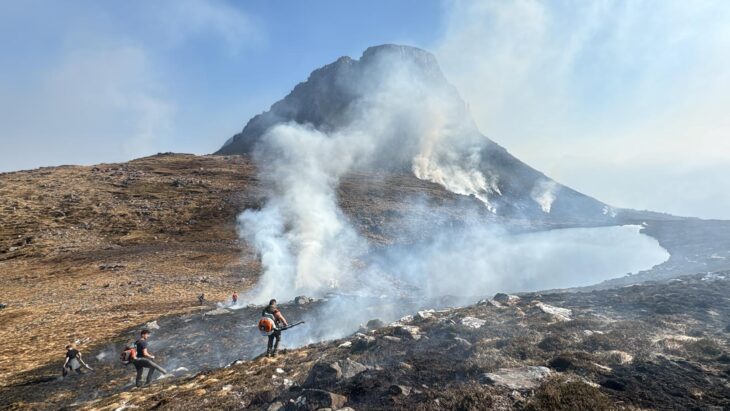
Partnership working to tackle the blaze © Robin Irvine
In addition to this huge input from the professional crews across the North Highlands, CALL partners and wider community provided invaluable support to the firefighting effort:
- Tim Hamlet from Assynt Mountain Rescue operated a camera drone which enabled SFRS to track the progress of the fire and strategize the approach to fighting it.
- Of course, the Davies family of Inverpolly estate were closely involved in fighting the fire.
- The Tanera Mòr team provided particularly generous support, with plentiful equipment, a sizeable crew (15 on day one; 30 on day two) – many of whom have received firefighting training – and an impressive lunch. Their Hagglunds BV206 vehicle was particularly useful, bussing crews over the bog to swiftly access the fire sites.
- Other nearby estates – including Assynt Foundation, Inchnadamph and Inver & Kirkaig Fishings, the Scottish Wildlife Trust, as well as experienced members of the community – contributed equipment, people-power and other support.
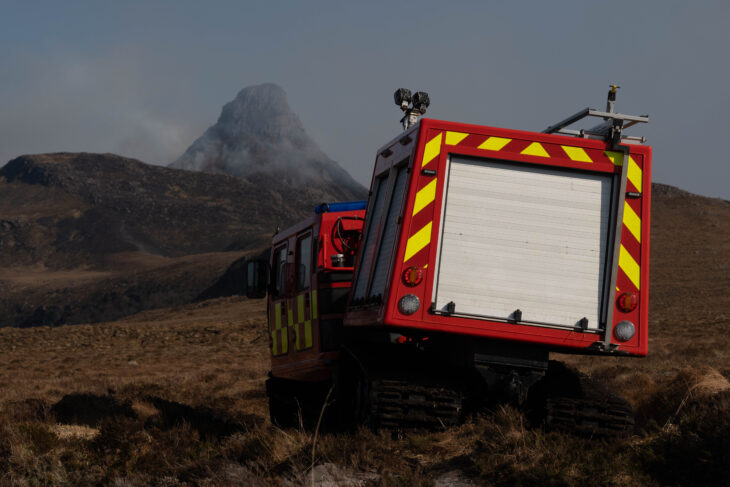
The Tanera Mòr team’s Hagglunds BV206 transporting fire crews to the site © Tim Hamlet – Assynt Mountain Rescue
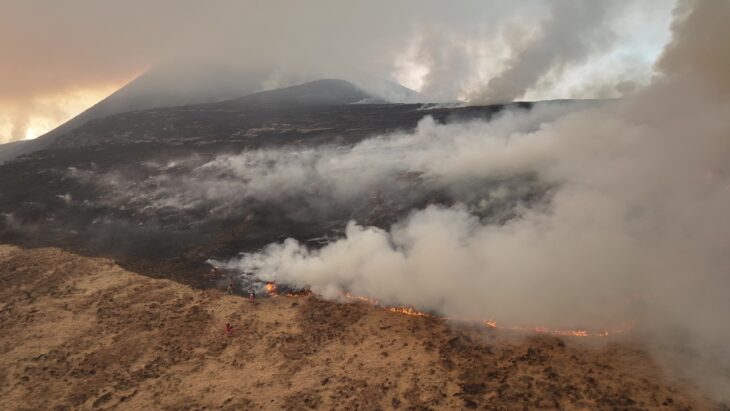
Fire crews fighting the fire on the ground © Tim Hamlet – Assynt Mountain Rescue
- Effective coordination, communication and collaboration were essential for efficiency and – crucially – the safety of all involved. The recently-enlarged Stac Pollaidh car park was a perfect base from which to control operations (and reinvigorate hungry firefighters at the well-stocked welfare station).
- All volunteers were asked to report to this Rendez-Vous Point before heading onto the hill, so the SFRS Incident Commander knew who was involved at any time.
- The CALL Wildfire WhatsApp group enabled communication amongst the volunteers (both those on the hill and others offering support from further afield) and between the volunteers and the SFRS team.
- In this specific situation – on the short heather that dominates the slopes of Stac Pollaidh – the army of leaf blowers provided by the volunteers was hugely effective, in combination with more traditional fire beaters. It was astonishing how quickly a hillside of flames could be extinguished. However, leaf blowers are not so effective in longer vegetation or when flames are more than 1.5m high.
- The drone footage was not only of practical assistance to the fire fighters: it provided ideal material for media outlets, helping to raise awareness amongst the public about the risks of wildfire locally and nationally.
- The response wasn’t all perfect: although no serious personal damage was done, we will certainly be more insistent on volunteers wearing face masks to prevent breathing difficulties.
By 9 o’clock on Monday evening – 36 hours after the first crew arrived on site – the fire was deemed to be extinguished, and everyone was safely off the hill. The fire destroyed 4.48km2 of valuable habitat but – due to the indomitable team – it was kept away from most of the rare oak and birch woodlands.
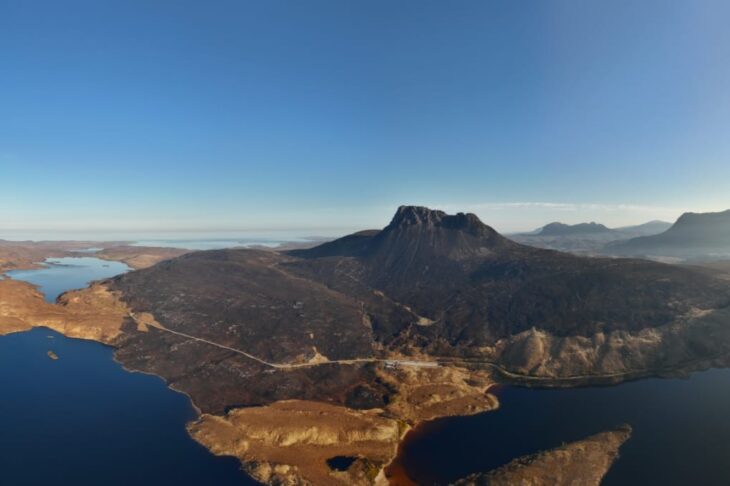
Stac Pollaidh, the morning after the fire © Tim Hamlet – Assynt Mountain Rescue
The sight of this beloved landmark engulfed in smoke, and glowing scarlet at nightfall, was haunting. But the collective effort to protect it and its wildlife was both humbling and inspiring.
We know there will be more wildfires in the area. We are now better prepared to collaborate effectively to overcome them. But, just as importantly, we urge everyone to be hugely cautious at all times.
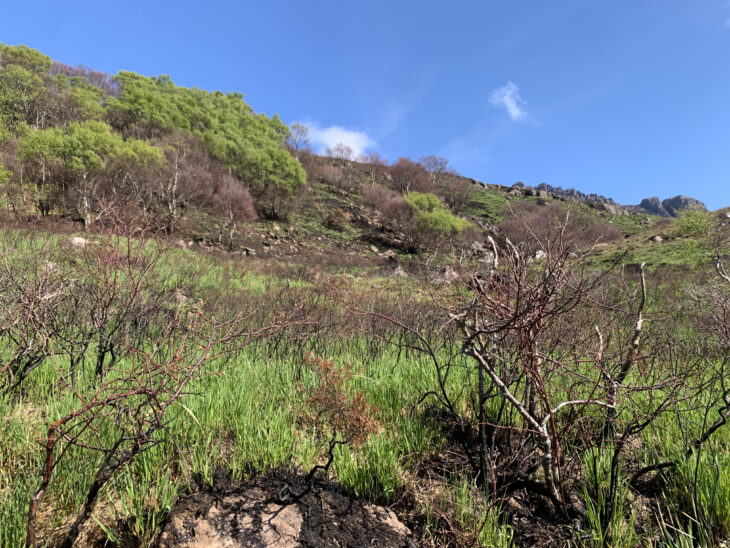
The first shoots of green since the fire, growing on the charred ground © Lizzie Wilder Williams
If you see signs of a wildfire, maintain a safe distance and call 999 as soon as possible. Do not attempt to tackle the fire, as this should only be done by those with the proper equipment, training and knowledge in how to do so safely.
For more information and advice, see the Ready Scotland wildfire webpage, and for up-to-date risk warnings, follow Scottish Fire and Rescue Service:
https://www.firescotland.gov.uk/news/.
Header image © Tim Hamlet – Assynt Mountain Rescue
